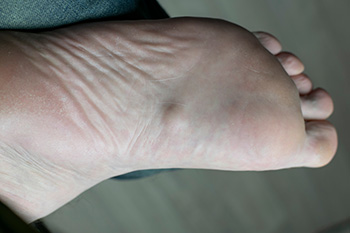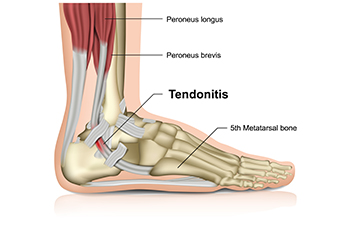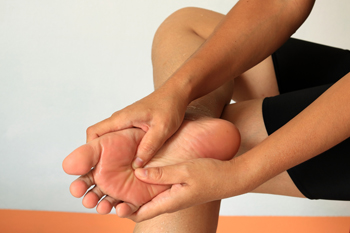Copyright © Michigan Foot and Ankle | Site Map | Nondiscrimination Policy | Design by: Podiatry Content Connection
July 2024
Understanding Plantar Fibromatosis and Ledderhose Disease

Plantar fibromatosis and Ledderhose disease are related conditions characterized by the development of benign nodules or lumps in the connective tissue of the feet, affecting the plantar fascia and foot arch. These nodules, composed of fibrous tissue, can cause pain and discomfort, particularly while standing or walking. Plantar fibromatosis typically affects the middle of the foot's underside, while Ledderhose disease occurs on the underside of the foot arch. These conditions often cause a feeling of pressure or a sensation akin to walking on pebbles. While symptoms can vary, they generally worsen with weight-bearing activities due to the increased pressure on the affected areas. Relief options include orthotic devices, steroid injections, and in severe cases, surgical removal of the nodules to alleviate pain and restore foot function. If you have nodules or lumps on the bottom of your foot, it is suggested that you consult a podiatrist who can accurately diagnose and treat these conditions.
A plantar fibroma may disrupt your daily activities. If you have any concerns, contact one of our podiatrists of Michigan Foot and Ankle. Our doctors can provide the care you need to keep you pain-free and on your feet.
Plantar Fibroma
A plantar fibroma is a fibrous knot in the arch of the foot. It is embedded in the plantar fascia which is a band of tissue that extends from the heel to the toes along the bottom of the foot. There can be multiple plantar fibromas in the feet at the same time. There are no known causes for this condition. If you have a plantar fibroma, there will be a bump in the arch of your foot that cannot be missed. Any associated pain is most often due to a shoe rubbing against the nodule. Non-surgical options, such as steroid injections, physical therapy, and orthotics should be tried first. Surgery is a last resort and is the only thing that will remove a plantar fibroma entirely. Consult with a podiatrist for a proper diagnosis and to determine the treatment regimen that is right for you.
What Causes a Plantar Fibroma?
While there are no specific causes identified, a plantar fibroma can possibly come from genetic predisposition or the formation of scar tissue that forms from healing the tears in the plantar fascia.
What Are the Symptoms of a Plantar Fibroma?
There will be a noticeable lump in the arch of the foot that may or may not cause pain. If pain is felt, it is typically because a shoe is rubbing up against the lump or when walking or standing barefoot.
Treatment and Prevention
A plantar fibroma will not disappear without treatment, but it can get smaller and be a non-issue. If pain persists, a podiatrist examines the foot and when the arch of the foot is pressed, pain can be felt down to the toes. An MRI or biopsy might be performed to help diagnose or evaluate the plantar fibroma. The following non-surgical options are generally enough to reduce the size and pain of these nodules:
- Steroid injections
- Orthotics
- Physical therapy to help apply anti-inflammatory creams on the bump
Surgery is considered if the mass increases in size and the patient continues to feel pain after non-surgical methods are tried.
If you have any questions please feel free to contact one of our offices located in Ferndale, and Milford, MI . We offer the newest diagnostic tools and technology to treat your foot and ankle needs.
Causes and Relief Options for Achilles Tendonitis

Achilles tendonitis is an inflammation of the Achilles tendon, the band connecting the calf muscles to the heel bone. This condition often arises from overuse, such as repetitive stress from activities like running or jumping. It can also result from a sudden increase in exercise intensity, wearing poor footwear, or tight calf muscles. Symptoms can include pain and stiffness along the tendon, especially in the morning or after physical activity. Relief options focus on reducing inflammation and promoting healing. Resting the affected foot can alleviate pain and swelling. Taking anti-inflammatory medications can also help to provide additional relief. Gentle stretching and strengthening exercises may restore flexibility and prevent future issues. Additionally, wearing supportive footwear and orthotics can also aid recovery. If you have pain in your heel and calf area, it is suggested that you consult a podiatrist who can accurately diagnose and treat an Achilles tendon injury.
Achilles tendon injuries need immediate attention to avoid future complications. If you have any concerns, contact one of our podiatrists of Michigan Foot and Ankle. Our doctors can provide the care you need to keep you pain-free and on your feet.
What Is the Achilles Tendon?
The Achilles tendon is a tendon that connects the lower leg muscles and calf to the heel of the foot. It is the strongest tendon in the human body and is essential for making movement possible. Because this tendon is such an integral part of the body, any injuries to it can create immense difficulties and should immediately be presented to a doctor.
What Are the Symptoms of an Achilles Tendon Injury?
There are various types of injuries that can affect the Achilles tendon. The two most common injuries are Achilles tendinitis and ruptures of the tendon.
Achilles Tendinitis Symptoms
- Inflammation
- Dull to severe pain
- Increased blood flow to the tendon
- Thickening of the tendon
Rupture Symptoms
- Extreme pain and swelling in the foot
- Total immobility
Treatment and Prevention
Achilles tendon injuries are diagnosed by a thorough physical evaluation, which can include an MRI. Treatment involves rest, physical therapy, and in some cases, surgery. However, various preventative measures can be taken to avoid these injuries, such as:
- Thorough stretching of the tendon before and after exercise
- Strengthening exercises like calf raises, squats, leg curls, leg extensions, leg raises, lunges, and leg presses
If you have any questions please feel free to contact one of our offices located in Ferndale, and Milford, MI . We offer the newest diagnostic tools and technology to treat your foot and ankle needs.
Causes of Pain in the Ball of the Foot

Pain in the ball of the foot, medically referred to as metatarsalgia, can stem from injuries, neuromas, and ill-fitting footwear. Common among athletes and high heel wearers, this pain often results from improper weight distribution across the metatarsal bones. Pain in the ball of the foot also may be the result of Morton’s neuroma, where nerve tissue in the ball of the foot becomes swollen. Foot injuries such as fractures, gout, arthritis, and bunions can also contribute to this metatarsal pain. High heels, in particular, tend to compress the toes and place excessive pressure on the ball of the foot, making matters worse. Persistent pressure or friction from tight shoes can cause calluses that add to the pain. Proper footwear with ample room for the toes and cushioning around the ball of the foot is essential for preventing and managing pain. If you are experiencing pain in the ball of your foot, it is suggested that you make an appointment with a podiatrist for an exam and treatment.
Foot Pain
Foot pain can be extremely painful and debilitating. If you have a foot pain, consult with one of our podiatrists from Michigan Foot and Ankle. Our doctors will assess your condition and provide you with quality foot and ankle treatment.
Causes
Foot pain is a very broad condition that could be caused by one or more ailments. The most common include:
- Bunions
- Hammertoes
- Plantar Fasciitis
- Bone Spurs
- Corns
- Tarsal Tunnel Syndrome
- Ingrown Toenails
- Arthritis (such as Gout, Rheumatoid, and Osteoarthritis)
- Flat Feet
- Injury (from stress fractures, broken toe, foot, ankle, Achilles tendon ruptures, and sprains)
- And more
Diagnosis
To figure out the cause of foot pain, podiatrists utilize several different methods. This can range from simple visual inspections and sensation tests to X-rays and MRI scans. Prior medical history, family medical history, and any recent physical traumatic events will all be taken into consideration for a proper diagnosis.
Treatment
Treatment depends upon the cause of the foot pain. Whether it is resting, staying off the foot, or having surgery; podiatrists have a number of treatment options available for foot pain.
If you have any questions, please feel free to contact one of our offices located in Ferndale, and Milford, MI . We offer the newest diagnostic and treatment technologies for all your foot care needs.
Are Bunions Affecting Your Everyday Life?
Stretching Can Help With Chronic Heel Pain
 Heel pain, often caused by plantar fasciitis, is a common condition characterized by inflammation of the plantar fascia, a thick band of tissue running along the bottom of the foot. This condition typically results from overuse, wearing poor footwear, or excessive standing and walking, leading to micro-tears in the fascia that cause pain and stiffness, especially in the morning. Treatment for plantar fasciitis usually involves rest, anti-inflammatory medications, and wearing supportive footwear. However, incorporating regular stretching into the treatment regimen can significantly alleviate chronic cases. Stretching exercises target the plantar fascia, Achilles tendon, and calf muscles, helping to increase flexibility, reduce tension, and promote healing. Techniques such as calf stretches, towel stretches, and plantar fascia-specific stretches can be particularly effective in managing symptoms and preventing recurrence. If you have persistent or severe heel pain, it is suggested that you consult a podiatrist, who can provide specialized care and further treatment options.
Heel pain, often caused by plantar fasciitis, is a common condition characterized by inflammation of the plantar fascia, a thick band of tissue running along the bottom of the foot. This condition typically results from overuse, wearing poor footwear, or excessive standing and walking, leading to micro-tears in the fascia that cause pain and stiffness, especially in the morning. Treatment for plantar fasciitis usually involves rest, anti-inflammatory medications, and wearing supportive footwear. However, incorporating regular stretching into the treatment regimen can significantly alleviate chronic cases. Stretching exercises target the plantar fascia, Achilles tendon, and calf muscles, helping to increase flexibility, reduce tension, and promote healing. Techniques such as calf stretches, towel stretches, and plantar fascia-specific stretches can be particularly effective in managing symptoms and preventing recurrence. If you have persistent or severe heel pain, it is suggested that you consult a podiatrist, who can provide specialized care and further treatment options.
Why Stretching Is Important for Your Feet
Stretching the feet is a great way to prevent injuries. If you have any concerns with your feet consult with one of our podiatrists from Michigan Foot and Ankle. Our doctors will assess your condition and provide you with quality foot and ankle treatment.
Stretching the Feet
Stretching the muscles in the foot is an important part in any physical activity. Feet that are tight can lead to less flexibility and make you more prone to injury. One of the most common forms of foot pain, plantar fasciitis, can be stretched out to help ease the pain. Stretching can not only ease pain from plantar fasciitis but also prevent it as well. However, it is important to see a podiatrist first to determine if stretching is right for you. Podiatrists can also recommend other ways to stretch your feet. Once you know whether stretching is right for you, here are some excellent stretches you can do.
- Using a foam roller or any cylindrical object (a water bottle or soda can will do), roll the object under your foot back and forth. You should also exert pressure on the object. Be sure to do this to both feet for a minute. Do this exercise three times each.
- Similar to the previous exercise, take a ball, such as a tennis ball, and roll it under your foot while seated and exert pressure on it.
- Grab a resistance band or towel and take a seat. If you are using a towel, fold it length wise. Next put either one between the ball of your foot and heel and pull with both hands on each side towards you. Hold this for 15 seconds and then switch feet. Do this three times for each foot.
- Finally hold your big toe while crossing one leg over the other. Pull the toe towards you and hold for 15 seconds. Once again do this three times per foot.
It is best to go easy when first stretching your foot and work your way up. If your foot starts hurting, stop exercising to ice and rest the foot. It is advised that you then see a podiatrist for help.
If you have any questions, please feel free to contact one of our offices located in Ferndale, and Milford, MI . We offer the newest diagnostic and treatment technologies for all your foot care needs.
Safely Working on the Feet During Pregnancy

Working on your feet while pregnant presents unique challenges that require special attention to maintain comfort and health. Although standing all day is generally thought to be safe for most pregnant women, taking breaks to sit or move around can significantly ease the strain on your body. That said, if you are at a high risk of preterm delivery or have concerns about your baby's growth, it is essential to avoid prolonged standing. For those who need to stand for extended periods, positioning and movement are important to note. Keep your knees soft, space your legs apart, and engage your core muscles to reduce pressure on the knees and feet. Periodically move your legs by walking or shifting weight to help maintain blood circulation and minimize swelling. Elevating one foot on a low stool can also alleviate lower back stress. Comfortable footwear with good arch support and a low heel is essential, in addition to wearing compression socks to enhance blood flow and reduce swelling. If you experience foot pain or unusual swelling after working on your feet, it is suggested that you schedule an appointment with a podiatrist for an exam and options for treatment.
While working on the feet, it is important to take the proper care of them. For more information about working on your feet, contact one of our podiatrists from Michigan Foot and Ankle. Our doctors will treat your foot and ankle needs.
Working on Your Feet
Standing on your feet for long periods of time can cause stress and pain in your feet. Your whole body may experience change in terms of posture, back pain, bunions, callouses and or plantar warts. There are ways to avoid these conditions with proper foot care, smart choices and correct posture.
Positive Changes
Negative heeled shoe – Choosing this shoe type places the heel slightly lower than the ball of the foot. These are great for overall foot health. Find shoes that fit you correctly.
Go barefoot – Our feet were not designed to be enclosed for all hours of the day. Try to periodically expose your feet to air.
Eliminate Pain
Foot Exercises – Performing simple exercises, incorporating yoga and doing stretches are beneficial. This will allow increased blood flow to the area and muscles of the foot.
Achilles tendon – Stretching the foot out flat on the floor will relax the calf muscles and tendon. These exercises can be performed almost anywhere. Make sure you add these exercises to your daily regimen.
With a little bit of this information and knowing more about foot health, you will notice changes. Foot stretches and proper footwear will help with pain and prevent further issues.
If you have any questions please feel free to contact one of our offices located in Ferndale, and Milford, MI . We offer the newest diagnostic and treatment technologies for all your foot and ankle needs.







